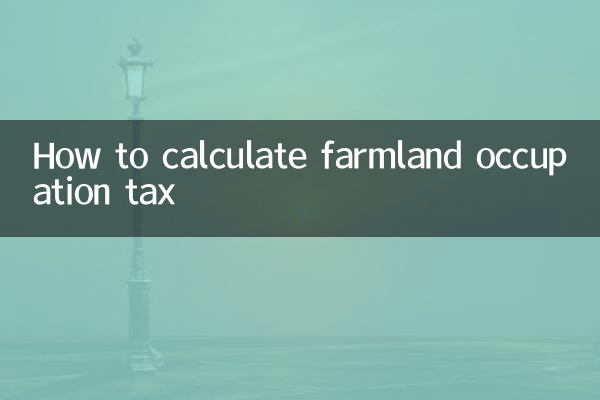How to calculate farmland occupation tax
In recent years, with the acceleration of urbanization, the issue of cultivated land occupation has attracted increasing attention. As an important means of economic regulation, cultivated land occupation tax aims to protect cultivated land resources and promote rational use of land. This article will introduce in detail the calculation method of farmland occupation tax, and provide you with a comprehensive interpretation based on the hot topics and hot content on the Internet in the past 10 days.
1. Basic concepts of farmland occupation tax

Farmland occupation tax refers to a tax levied on units and individuals who occupy farmland for non-agricultural construction. Its purpose is to inhibit cultivated land occupation behavior and protect cultivated land resources through economic means. According to the Farmland Occupation Tax Law of the People's Republic of China, the scope of farmland occupation tax includes the occupation of farmland for building houses, building roads, building factories and other non-agricultural purposes.
2. Calculation method of farmland occupation tax
The calculation of farmland occupation tax is mainly based on the area of occupied farmland, land grade and applicable tax rate. The specific calculation formula is as follows:
| Project | Description |
|---|---|
| taxable area | Actual occupied cultivated land area (unit: square meters) |
| Applicable tax rate | Determined based on land grade and regional differences (unit: yuan/square meter) |
| tax payable | Taxable area × applicable tax rate |
For example, if an enterprise occupies 1,000 square meters of cultivated land and the local applicable tax rate is 30 yuan/square meter, the tax payable is 1,000 × 30 = 30,000 yuan.
3. Rate standards for cultivated land occupation tax
The tax rate for cultivated land occupation tax is determined by each province, autonomous region, and municipality directly under the Central Government based on local actual conditions, but it shall not be lower than the minimum standard stipulated by the state. The following is a reference for tax rates in some regions:
| area | Tax rate (yuan/square meter) |
|---|---|
| Beijing | 50 |
| Shanghai | 45 |
| Guangdong | 35 |
| Sichuan | 25 |
4. Preferential policies for farmland occupation tax
In order to encourage the rational use of land resources, the state provides farmland occupation tax exemptions and exemptions in some cases. The following are common preferential policies:
| situation | Preferential policies |
|---|---|
| Military installations occupy cultivated land | exempt from tax |
| Schools and kindergartens occupy cultivated land | exempt from tax |
| Rural residents occupy farmland when building houses | halved collection |
5. The correlation between recent hot topics and farmland occupation tax
1.Rural Revitalization Strategy: Recently, the country has once again emphasized the importance of rural revitalization, and farmland protection has become a hot topic. The strict collection of cultivated land occupation tax will help curb the illegal occupation of cultivated land and ensure the sustainable development of agriculture.
2.Urban expansion and farmland protection: With the continuous expansion of urban boundaries, the problem of cultivated land occupation has become increasingly prominent. Many local governments have increased penalties for illegal land occupation by raising farmland occupation tax rates.
3.Environmental protection policies are tightened: Recently, environmental protection policies have become stricter. As one of the economic means of environmental protection, farmland occupation tax has been used in many places to regulate land use and reduce ecological damage.
6. How to declare farmland occupation tax
1.Declaration subject: Units and individuals occupying farmland.
2.Declaration time: Generally within 30 days after obtaining the land use rights.
3.Application materials: Including land occupation certificate, land grade certificate, identity certificate, etc.
4.Declaration process: Submit declaration materials to the local tax authorities and pay the tax after approval.
7. Summary
The calculation of farmland occupation tax involves multiple factors such as taxable area and applicable tax rate. The tax rates vary greatly in different regions. It is the responsibility of every unit and individual to make rational use of farmland resources and pay taxes in accordance with the law. Recent hot topics such as rural revitalization and urban expansion have further highlighted the importance of farmland protection. Understanding the calculation methods and related policies of farmland occupation tax can help to better plan land use and avoid unnecessary economic losses.

check the details

check the details